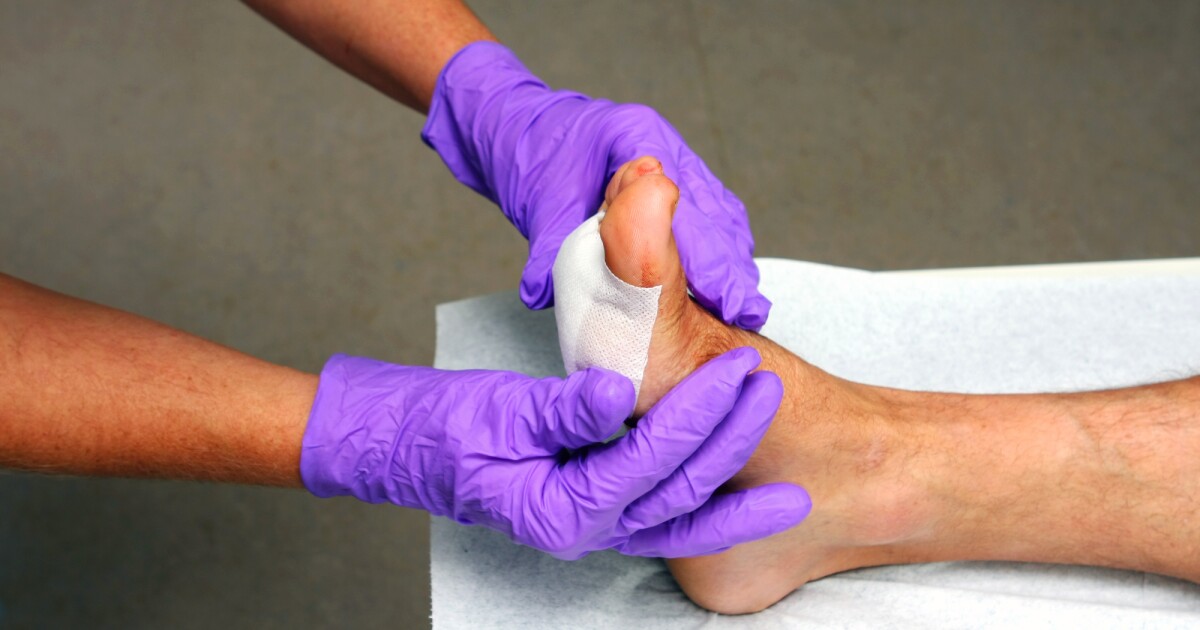
In diabetics, wounds tend to progress quickly and heal slowly. Researchers have developed a method that uses electricity to heal diabetic wounds three times faster and offers great potential for treating those with diseases that lead to reduced wound healing.
Diabetics are 15 times more likely to have amputations because of foot wounds and ulcers. So, it’s important to keep an eye on even small cuts, grazes, and scratches that have the potential to develop into larger wounds.
When diabetes is poorly controlled, blood glucose levels are higher than they should be. As a result, nutrients and oxygen are prevented from energizing cells, the immune system doesn’t function as efficiently, and there is generalized inflammation in the body. These things slow down the wound-healing process and increase the risk of an infection developing. Wound repair can also be slower in the elderly, people with poor circulation, and those with spinal injuries.
Enter researchers from Chalmers University of Technology, Sweden, and the University of Freiburg, Germany, who’ve developed a method that uses electricity to speed up the healing of chronic wounds, particularly in diabetics.
“Chronic wounds are a huge societal problem that we don’t hear a lot about,” said Maria Asplund, corresponding author of the study. “Our discovery of a method that may heal wounds up to three times faster can be a game changer for diabetic and elderly people, among others, who often suffer greatly from wounds that won’t heal.”
Using electricity to stimulate healing is not a new thing. In recent years we've seen the development of smart bandages and bandages that zap wounds before dissolving.
The principle underlying the use of electricity to promote healing is that skin cells are electrotactic, meaning that if an electric field is placed in a Petri dish full of skin cells, the cells will migrate towards it. In the current study, the researchers investigated using this principle to electrically guide cells to heal wounds quicker, particularly in diabetics.
They focused on keratinocytes – the most dominant cell type found in the skin – which play an essential role in skin repair. When they’re undertaking skin repair, keratinocytes migrate as a collective.
The researchers created a microfluidic platform capable of sustaining direct current (DC) electrical stimulation over hours by combining laser-induced graphene (LIG) and an integrated hydrogel. LIG is made by converting polymers into a porous 3D form of graphene. Using a tiny, engineered ‘wound-on-a-chip,’ they assessed electrically stimulated wound healing, first on healthy cells and then on cells mimicking diabetic keratinocytes.
“We were able to show that the old hypothesis about electric stimulation can be sued to make wounds heal significantly faster,” said Asplund. “In order to study exactly how this works for wounds, we developed a kind of biochip on which we cultured skin cells, which we then made tiny wounds in. Then we stimulated one wound with an electric field.”
Using a low electric field, about 200 mV/mm, they found that DC stimulation resulted in faster wound closure in all cases and did not negatively affect the cells. The wound-healing effect was also stronger when the current was applied to only one side of the wound as opposed to both sides. Unidirectional stimulation led to full wound closure at 10 hours, compared to the non-stimulated wound, which, at that time, was only around 36% closed. This amounts to nearly a threefold increase in wound closure rate.
When the researchers applied an electric current to the ‘diabetic’ cells, they found that after 12 hours of unidirectional stimulation, the cells were around 34% closed compared to about 12% in the non-stimulated controls. The results were comparable to those seen in healthy cells, leading the researchers to conclude that electrical cell guidance causes faster wound closure, including in diabetics.
“We’ve looked at diabetes models of wounds and investigated whether our method could be effective in those cases,” Asplund said. “We saw that when we mimic diabetes in the cells, the wounds on the chip heal very slowly. However, with electric stimulation we can increase the speed of healing so that the diabetes-affected cells almost correspond to healthy skin cells.”
Importantly, the researchers achieved these results without using salt bridges, tubes containing an electrolyte that provides electrical contact between two solutions. This, they say, should allow for easier translation of the technique to 3D models.
They plan to continue researching to develop marketable wound healing products tailored for individual use.
“We are now looking at how different skin cells interact during stimulation, to take a step closer to a realistic wound,” Asplund said. “We want to develop a concept to be able to ‘scan’ wounds and adapt the stimulation based on an individual wound. We are convinced that this is the key to effectively helping individuals with slow-healing wounds in the future.”
The study was published in the journal Lab on a Chip.
Source: Chalmers University of Technology
"electric" - Google News
April 27, 2023 at 09:49AM
https://ift.tt/mJK18cW
Electrical stimulation heals diabetic wounds three times faster - New Atlas
"electric" - Google News
https://ift.tt/fVzvGu1
https://ift.tt/9ORWAha
Bagikan Berita Ini















0 Response to "Electrical stimulation heals diabetic wounds three times faster - New Atlas"
Post a Comment